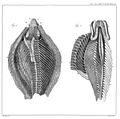Patrick Russell (herpetologist) facts for kids

Patrick Russell (born February 6, 1726, in Edinburgh, Scotland – died July 2, 1805, in London) was a Scottish doctor and scientist who studied nature. He spent many years working in India. He is especially famous for his studies of snakes in India. Because of his important work, he is often called the "Father of Indian Ophiology" (which is the study of snakes). A very well-known snake, Russell's viper (Daboia russelii), is named after him.
Contents
Patrick Russell's Early Life and Education
Patrick Russell was born into a well-known family in Edinburgh. His father, John Russell, was a lawyer. Patrick was the fifth son and had several half-brothers, including Alexander Russell and William Russell, who were also famous scientists.
Patrick went to high school in Edinburgh, where he studied old Roman and Greek writings. After that, he went to the University of Edinburgh to study medicine. He became a Doctor of Medicine in 1750.
Soon after, he joined his older half-brother, Alexander Russell, in Aleppo, Syria. Alexander was a doctor for a trading company called the Levant Company. He was also very interested in nature and knew a lot about the local languages.
Working in Aleppo, Syria
In 1753, Alexander Russell left Aleppo and went back to London. Patrick took over his brother's job as a doctor there. He worked in Aleppo for about 18 years. The local ruler, the Pasha of Aleppo, thought very highly of Patrick.
Patrick was a careful observer. He learned about a local practice where people would give children a mild form of smallpox to protect them from getting seriously sick. This was an early type of vaccination.
Aleppo faced outbreaks of a serious disease called bubonic plague in the early 1760s. Patrick studied how the disease spread and how to avoid getting sick. For example, he suggested breathing through a handkerchief soaked in vinegar. He also noticed that fleas, which can carry diseases, became fewer after very hot weather. He saw that plague cases also went down during these times.
Patrick continued to study nature. After his brother Alexander died in 1768, Patrick updated Alexander's book, Natural History of Aleppo, in 1794.
Returning to England
In 1771, Patrick Russell left Aleppo. He traveled through Italy, looking at how different places tried to stop diseases from spreading. He first planned to work in Edinburgh, but a famous doctor named John Fothergill convinced him to move to London instead. Dr. Fothergill was a friend of Patrick's brother, Alexander, and was also a founder of a botanical garden.
In London, Patrick met other important scientists like Sir Joseph Banks. In 1777, Patrick was chosen to be a Fellow of the Royal Society, which is a group of very important scientists.
Studying Nature in India
In 1781, Patrick's younger brother, Claud, became an important leader for the British East India Company in Visakhapatnam, India. Claud was not well, so the family asked Patrick to go to India to help him.
When Patrick arrived in India, he started to study the plants and animals of the region. The East India Company had a scientist named Dr. John Koenig who studied nature. When Dr. Koenig died in 1785, the Governor of Madras personally offered Patrick the job of 'Botanist and Naturalist'.
This job was very demanding! The Company expected their naturalist to be good at many things. They wanted him to know languages, study people, look for old things, observe the weather, study rocks, and understand animals, all in addition to studying plants.
Patrick Russell's Work with Snakes
Just as he had studied nature in Aleppo, Russell wrote about the plants and animals of Madras. As a doctor for the East India Company, he was very concerned about snakebites. He made it his main goal to find a way for people to tell the difference between venomous snakes (which are dangerous) and non-venomous snakes (which are not).
He collected many plants and also identified a snake called Katuka Rekula Poda. He noted that this snake was not well known to Europeans but was almost as deadly as the cobra.
Patrick Russell tried to classify snakes by looking at their scales. His main goal was to find a simple way to tell if a snake was venomous or not. He even did experiments on dogs and chickens to see the effects of snake venom and described the symptoms. He also tested popular remedies for snakebite, like a pill from Tanjore, and found that they did not work.
In one case, a soldier who was very sick from a snakebite was brought to him. The common treatment used by Europeans was to give the patient warm Madeira wine. Patrick gave the soldier two bottles of the wine, and the soldier completely recovered.
Patrick, his brother Claud, and their family left India for England in January 1791. Some of the things he collected were placed in a museum in Madras. He also took some snake skins back to London, which are now in the Natural History Museum.
Publishing His Snake Studies
Back in England, Patrick Russell worked on a book about snakes. The East India Company helped publish it. The first part of his book, An Account of Indian Serpents Collected on the Coast of Coromandel, came out in 1796. It had 44 detailed pictures. The second part was published in four sections, with the first two coming out in 1801 and 1802. These included 46 colored pictures.
Patrick Russell passed away on July 2, 1805, after a short illness. He never married. The last two parts of his second book were published after his death, in 1807 and 1809.
He also wrote scientific papers. For example, he showed that the special pits on the faces of pit vipers were not used for hearing. Another paper explained how a cobra can spread its hood on purpose.
Images for kids






